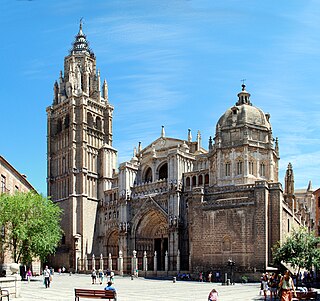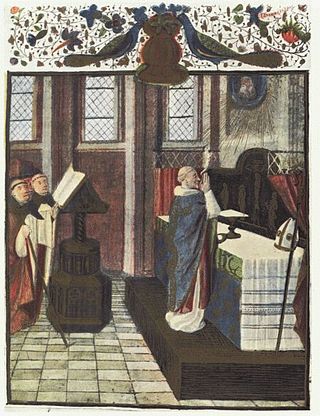Latin is an Italic language, originally spoken in ancient Rome and its empire.
Orientalium Ecclesiarum, subtitled the Decree on the Eastern Catholic Churches is one of the Second Vatican Council's 16 magisterial documents. "Orientalium Ecclesiarum" is Latin for "of the Eastern Churches," and is taken from the first line of the decree.

A sacred language, holy language or liturgical language is any language that is cultivated and used primarily for religious reasons by people who speak another, primary language in their daily lives.

The Mozarabic Rite, officially called the Hispanic Rite, and in the past also called the Visigothic Rite, is a liturgical rite of the Latin Church once used generally in the Iberian Peninsula (Hispania), in what is now Spain and Portugal. While the liturgy is often called 'Mozarabic' after the Christian communities that lived under Muslim rulers in Al-Andalus that preserved its use, the rite itself developed before and during the Visigothic period. After experiencing a period of decline during the Reconquista, when it was superseded by the Roman Rite in the Christian states of Iberia as part of a wider programme of liturgical standardization within the Catholic Church, efforts were taken in the 16th century to revive the rite and ensure its continued presence in the city of Toledo, where it is still celebrated today. It is also celebrated on a more widespread basis throughout Spain and, by special dispensation, in other countries, though only on special occasions.
Christian liturgy is a pattern for worship used by a Christian congregation or denomination on a regular basis. The term liturgy comes from Greek and means "public work". Within Christianity, liturgies descending from the same region, denomination, or culture are described as ritual families.

The Roman Rite is the most common ritual family for performing the ecclesiastical services of the Latin Church, the largest of the sui iuris particular churches that comprise the Catholic Church. The Roman Rite governs rites such as the Roman Mass and the Liturgy of the Hours as well as the manner in which sacraments and blessings are performed.

Pre-Tridentine Mass refers to the variants of the liturgical rite of Mass in the West before 1570, when, with his bull Quo primum, Pope Pius V made the Roman Missal, as revised by him, obligatory throughout the Latin Church, except for those places and congregations whose distinct rites could demonstrate an antiquity of two hundred years or more.

Latin liturgical rites, or Western liturgical rites, is a large family of liturgical rites and uses of public worship employed by the Latin Church, the largest particular church sui iuris of the Catholic Church, that originated in Europe where the Latin language once dominated. Its language is now known as Ecclesiastical Latin. The most used rite is the Roman Rite.

The Mass is the central liturgical service of the Eucharist in the Catholic Church, in which bread and wine are consecrated and become the body and blood of Christ. As defined by the Church at the Council of Trent, in the Mass "the same Christ who offered himself once in a bloody manner on the altar of the cross, is present and offered in an unbloody manner". The Church describes the Mass as the "source and summit of the Christian life", and teaches that the Mass is a sacrifice, in which the sacramental bread and wine, through consecration by an ordained priest, become the sacrificial body, blood, soul, and divinity of Christ as the sacrifice on Calvary made truly present once again on the altar. The Catholic Church permits only baptised members in the state of grace to receive Christ in the Eucharist.
Latinisation or Latinization can refer to:

The Priestly Society of Saint Josaphat Kuntsevych (SSJK) is a society of traditionalist priests and seminarians originating from the Ukrainian Greek Catholic Church which is led by the excommunicated priest Basil Kovpak. It is based in Riasne, Lviv, Western Ukraine. In Lviv, the society maintains a seminary, at which currently thirty students reside, and takes care of a small convent of Basilian sisters. The SSJK is affiliated with the Society of St. Pius X and Holy Orders are conferred by the latter society's bishops in the Roman Rite. The SSJK clergymen, however, exclusively follow a version of Slavonic Byzantine Rite in the Ruthenian recension.
Liturgical Latinisation is the process of adoption of Latin liturgical rites by non-Latin Christian denominations, particularly within Eastern Catholic liturgy. Throughout history, liturgical Latinisation was manifested in various forms. In Early Middle Ages, it occurred during the process of conversion of Gothic Christianity, and also during the process of reincorporation of Celtic Christianity. During the Crusades, it was introduced to Eastern Christians. After the creation of various Eastern Catholic Churches, several forms and degrees of liturgical Latinisation were adopted by some of those Churches, in order to make their liturgical customs resembling more closely the practices of the Roman Rite of the Catholic Church.
The Malankara Rite is the form of the West Syriac liturgical rite practiced by several churches of the Saint Thomas Christian community in Kerala, India. West Syriac liturgy was brought to India by the Syriac Orthodox Bishop of Jerusalem, Gregorios Abdal Jaleel, in 1665; in the following decades the Malankara Rite emerged as the liturgy of the Malankara Church, one of the two churches that evolved from the split in the Saint Thomas Christian community in the 17th century. Today it is practiced by the various churches that descend from the Malankara Church, namely the Malankara Mar Thoma Syrian Church, Malankara Orthodox Syrian Church, the Jacobite Syrian Christian Church, the Syro-Malankara Catholic Church and the Malabar Independent Syrian Church
Liturgical use of Latin is the practice of performing Christian liturgy in Ecclesiastical Latin. This practice is typically found in the context of liturgical rites of the Latin Church.

In the Catholic Church, preconciliar Latin liturgical rites coexist with postconciliar rites. In the years following the Second Vatican Council, Pope Paul VI initiated significant changes. Some of Paul VI's contemporaries, who considered the changes to be too drastic, obtained from him limited permission for the continued use of the previous Roman Missal. In the years since, the Holy See has granted varying degrees of permission to celebrate the Roman Rite and other Latin rites in the same manner as before the council. The use of preconciliar rites is associated with traditionalist Catholicism.
The Eastern Catholic Churches of the Catholic Church utilize liturgies originating in Eastern Christianity, distinguishing them from the majority of Catholic liturgies which are celebrated according to the Latin liturgical rites of the Latin Church. While some of these sui iuris churches use the same liturgical ritual families as other Eastern Catholic churches and Eastern churches not in full communion with Rome, each church retains the right to institute its own canonical norms, liturgical books, and practices for the ritual celebration of the Eucharist, other sacraments, and canonical hours.
Catholic liturgy can refer to the various Christian liturgies of the Catholic Church. It may also refer to various particular liturgies and liturgical rites:







